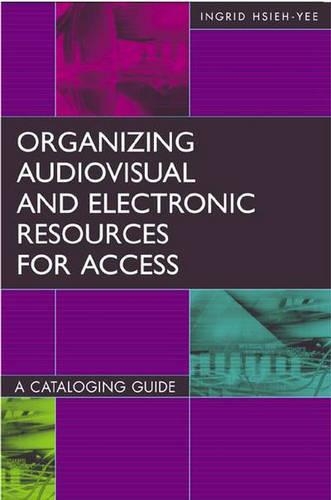
Organizing Audiovisual and Electronic Resources for Access: A Cataloging Guide, 2nd Edition
(Paperback, 2nd Revised edition)
Publishing Details
Organizing Audiovisual and Electronic Resources for Access: A Cataloging Guide, 2nd Edition
By (Author) Ingrid P. Hsieh-Yee
Bloomsbury Publishing PLC
Libraries Unlimited Inc
30th January 2006
2nd Revised edition
United States
Classifications
Professional and Scholarly
Non Fiction
025.4
Physical Properties
Paperback
400
Description
This definitive guide reflects the 2002 revision of the Anglo-American Cataloguing Rules and its 2004 update, the latest version of the Library of Congress Rule Interpretations, and the CONSER Module 31. Basic topics include the principles of organization, the cataloging process, sound recordings, video recordings, electronic resources, resource integration, remote access electronic serials, and the challenges of organizing information in a digital environment. Examples of current standards for descriptive cataloging, choice of access points, and subject analysis abound, along with real life analyses of bibliographic records. CDs. DVDs. MP3s. Streaming videos. Electronic books. Web resources. Remote access electronic serials. These are but a few of the resources driving an increasing percentage of library user interests, influencing library collection development, and placing increased demands on the library cataloger's skill set. This definitive guide to performing descriptive cataloging and subject analysis on audiovisual and multimedia resources reflects the 2002 revision of the Anglo-American Cataloguing Rules and its 2004 update, the latest version of the Library of Congress Rule Interpretations, and the CONSER Module 31. Basic topics include the principles of organization, the cataloging process, sound recordings, video recordings and electronic resources, resource integration, remote access electronic serials, and the challenges of organizing information in a digital environment. The five materials chapters consist of an introduction to the formatfollowed by a discussion, with examples, of current standards for descriptive cataloging, choice of access points, and subject analysisand concludes with analyses of 10 bibliographic records. Designed for either self-study or classroom use, here is a guide no 21st-century library can afford to be without.
Reviews
As with the first edition, Hsieh-Yee continues to provide a good resource for helping new and experienced catalogers make the tricky cataloging decisions required by these complex formats.Hsieh-Yee's book has applications for the classroom and for catalogers seeking to understand the complexities of cataloging inthe formats that are increasingly the focus of the work. The richness of the context required to catalog these materials is provided by Hsieh-Yee's depth of understanding. * TechKNOW *
As libraries acquire more and more non-book items, or choose electronic resources over hard copy resources, the problem of how to catalog and organize them becomes more acute. Several books have been written recently on this topic, some more useful than others. Hsieh-Yee's contribution in one of the useful ones.[t]his book is recommended for cataloging classroom use and for any cataloger who would like a quick course in how to deal with modern media. * Technical Services Quarterly *
Hsieh-Yee's book offers guidance for both self-study and for course text use on cataloging the full spectrum of nonprint resources: sounds and video recordings, data files, Internet sites, and e-journals. As she notes in the preface, the AACR2 rules have evolved, particularly for electronic resources, and new Library of Congress rule interpretations have been issued as well. Thus, this book presents the most up-to-date standards and provides current illustrative examples to reflect these changes.This book fills a niche as an updated resource for cataloging nonprint materials.Technical services staff in all types of libraries, as well as students and faculty, will welcome this comprehensive, authoritative, and valuable addition to the library literature. * Reference & User Services Quarterly *
Ingrid Hsieh-Yee shares all the latest cataloging rules in this second edition of Organizing Audiovisual and Electronic Resources for Access. * American Libraries *
Author Bio
Ingrid Hsieh-Yee is professor in the School of Library and Information Science, Catholic University of America.
